Ratneshwar Mahadev temple
Ratneshwar Mahadev Mandir (Hindi: रत्नेश्वर महादेव मंदिर) (also known as Matri-rin Mahadev,or Leaning temple of Varanasi) is one of the most photographed temples in the holy city of Varanasi in Uttar Pradesh, North India. The temple, while apparently well-preserved, leans significantly towards the back side (north-west), and its garbhagriha is generally below the water much of the year, except for a few months during the summer.[2][3]
| Ratneshwar Mahadev Mandir | |
|---|---|
रत्नेश्वर महादेव मंदिर | |
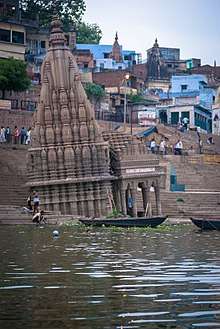 Ratneshwar Mahadev Temple | |
| Religion | |
| Affiliation | Hinduism |
| District | Varanasi |
| Deity | Shiva |
| Festivals | Mahashivratri |
| Location | |
| Location | Manikarnika Ghat, Varanasi |
| State | Uttar Pradesh |
| Country | |
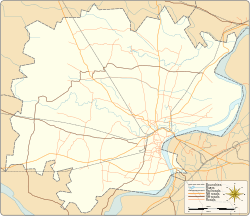 Temple location on Varanasi district map | |
| Geographic coordinates | 25.317645°N 82.973914°E |
| Architecture | |
| Completed | 19th century based upon records, earlier by legend |
| Elevation | 73.14[1] m (240 ft) |
There exists a temple by the same name in Karachi situated at the seaside of Clifton in natural cave.[4]
Architecture
The temple is elegantly constructed in the classical style with a nagara shikhara and phamsana mandapa.[5] The site of the temple is very unusual. Unlike all other temples in Varanasi on the coast of Ganga, the temple is built at a very low level. In fact, the water level can reach the shikhara part of the temple.[6]
It is constructed at a very low spot; the builder must have known that its garbhagriha would be underwater for much of the year. In spite of much of the temple being underwater during most of the year, it is well preserved, except for the lean that can be noted in 20th century photos.
The upper part of temple was sightly damaged in 2016 due to heavy rainfall and lightening.[7]
Legend
According to a popular legend, it was built by an unnamed servant of Raja Man Singh for his mother Ratna Bai about 500 years ago. After having built the temple, he proudly boasted that he paid his debt to his mother (Matru-run). However, since the debt to one's mother can never be repaid, the temple started leaning because of a curse by the mother.[3] That is the reason for the alternative name of the temple: Matru-run (Mother's debt). According to another story, it was built by a female servant of Ahilya Bai of Indore, named Ratna Bai. Ahilya Bai cursed it to lean because her servant had named it after herself.[3]
History
Some sources claim that was built by Queen Baija Bai of Gwalior in the 19th century.[3] According to the revenue records, it was constructed during 1825–1830. However, according to Dr. Ratnesh Varma of District Cultural Committee, it was constructed by the Amethi royal family in 1857.[8] James Prinsep, who was an assay master at the Banaras Mint during 1820–1830,[9] created a series of drawings, one of which includes the Ratneshwar Mahadev temple. He commented that when the temple entrance was underwater, the priest used to dive in the water to conduct worship.
Photographs from 1860s do not show the building leaning. Modern photographs show a lean of about 9 degrees (the Tower of Pisa leans about 4 degrees). The building is likely leaning because it is sinking into silt or due to a faulty foundation.[3] A lightning strike in 2015 caused slight damage to some of the elements of the shikhara.[3]
Location
The temple in Manikarnika Ghat is located in front to the Tarkeshwar Mahadev Mandir [10] built in 1795 by Ahilyabai Holkar[11] where Lord Shiva is said to recite the Taraka Mantra (salvation mantra). Between the two temple is a spot that was termed as the holiest spot in Banaras by James Prinsep in 1832.[12] An 1865 photograph terms one of the temples as the Vishnupad temple. It is likely the Ganesh temple with the Charan Paduka of Lord Vishnu near it (only distinguished individuals can be cremated at the spot[13]). The same spot is said to have been the site of a Sati in a 1903 print.[14]
Gallery

Munikurnuka Ghat Benares from the river by James Prinsep, 1832. Tarakeshwar temple on the left. .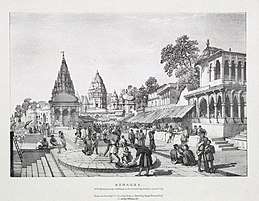
A Brahmin placing a garland on the holiest spot in the sacred city by James Prinsep 1832. Tarakeshwar temple on the left and Baba Mashan Nath temple in the center. .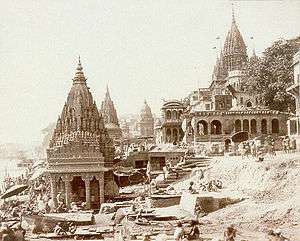
Vishnu Pud and Other Temples near the Burning Gat, Benares. Acquired by King Edward VII when Prince of Wales, 1865. The ghats are apparently under construction. ..jpg)
"Suttee" pillar, 1903 Stereograph .
date unknown .jpg)
1953 
Submerged temple, 2011. Taken from an angle that does not show the lean. 
date unknown 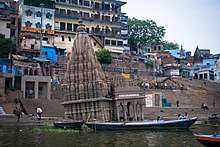
2013 
2015
References
- "Elevation". Elevation finder.
- पीसा की मीनार की तरह झुका हुआ है ये मंदिर, आज तक नहीं खुल पाया रहस्य dainikbhaskar.com, 14 September 2015
- The Leaning Temple of Varanasi, Sais, 3 April 2016
- SHRI RATNESHWAR MAHADEV MANDIR
- Temples Styles in North India (Nagara Style)
- Kashi Vishwanath JyotirLinga Temple Darshan in Varanasi - Part 1, at 8:28
- "आकाशीय बिजली का कहर : 400 वर्ष पुराने रत्नेश्वर महादेव मंदिर का ऊपरी हिस्सा क्षतिग्रस्त". NDTVIndia. Retrieved 14 February 2020.
- किसके श्राप से टेढ़ा हुआ था यह मंदिर, भरा रहता है कीचड़, पढ़ें 5 MYTHS, dainikbhaskar.com | 14 March 2016
- James Prinsep, ENGLISH ANTIQUARIAN, Encyclopaedia Britannica
- Shri Tarkeshwar Mahadev Mandir, Varanasi
- The Varanasi Heritage Dossier/Manikarnika Ghat
- A Brahmin placing a garland on the holiest spot in the sacred city by James Prinsep, 1832 print, Tarkeshwar Mahadev Mandir in the background
- Death in Banaras, Jonathan P. Parry Cambridge University Press, 7 July 1994 p. 50
- "Suttee" pillar where Hindu widows were burned, Benares, India, Stereograph, Ratneshwar Mahadev temple in the background

